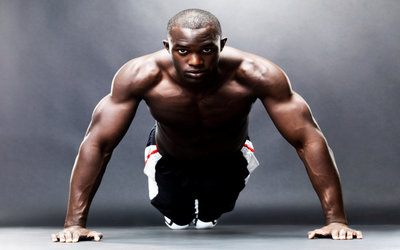Push-Ups: Two Variations that Make You Want to Try Them!
The push-up – is there anything more daunting to an aspiring fitness enthusiast? Sure, you can start jogging or take up yoga easily enough, but push-ups? No thanks! According to wellness expert Martin Rooney, who holds a Master of Health Science in physical therapy from the Medical University of South Carolina and a Bachelor of Arts in exercise science from Furman University, ‘During 25 years of training, I’ve seen push-ups used in high school gym classes, the military, and dojos, often as a form of punishment. With good reason: Push-ups are tough.’ So why, then, do people put their wellness through the mill by attempting to do push-ups?
Rooney notes, ‘While people at gyms spend lots of time on benches and other fancy equipment, push-ups may be an even more effective way to get you stronger, faster. And they’re far more versatile than people think.’ In fact, with the odd tweak here and there, push-ups can provide an amazing workout for your core and upper body (think flat abs and super-toned arms). So while the idea of attempting push-ups may not be so appealing to your sense of wellbeing, the results they can provide may be just enough to tempt you. However, before we get onto variations, we first need to establish the proper push-up technique.
‘Before you jump into variations of the classic push-up, be sure you get the original right,’ Rooney urges. ‘To maintain proper form, you must keep your back flat, abs tight, butt down, and shoulders rotated so that the crook of the elbow faces forward. This position ensures that your core is engaged and that your shoulders are in the position that’s the least likely to cause irritation. If your wrists bother you, perform the push-up on your knuckles, which keeps the wrists in a more neutral position.’ But how do you know if you’re actually getting it right?
Rooney points out, ‘There are a few classic form failures that can indicate glaring areas of weakness. If the low back sags, it shows that your core is weak. If the shoulder blades flare out from the body in the top position of the push-up, the Serratus Anterior (muscles along the side of your rib cage just underneath your arms) need work. Try doing Push-up Holds (which are just like a plank, only with your arms extended rather than resting on your elbows) for your core, and Mountain Climbers (same position as a push-up hold, only you make it more challenging by bringing your knees to your chest on alternating legs) for the Serratus Anterior.’
Now that we’ve got that sorted, let’s look at two push-up variations that put more demand on your core and upper body. In both versions, you change the position of your knees so that your abs, shoulders and hip flexors have to work overtime to keep you off the ground – and end up looking fabulous as a result!
1. Knee-To-Elbow Push-Up: ‘Begin at the top of the push-up position,’ Rooney instructs. ‘Keep your back straight and lower the torso under control. At the bottom of the push-up, bring your knee to the outside of your elbow. Then return your leg to the starting position and extend through your elbows until you reach the top of the push-up. Alternate sides on each rep.’
2. Knee-To-Chest Push-Up: Again, you begin at the top of the push-up position. Rooney advises, ‘Keep your back straight and lower the torso under control. Press back up with your arms, and at the top of the push-up, bring one knee up under the chest. Make sure your foot doesn’t touch the ground. Return your leg to its original position, then lower yourself back down and repeat, lifting the opposite leg. Continue alternating throughout the set.’


Comments are closed.